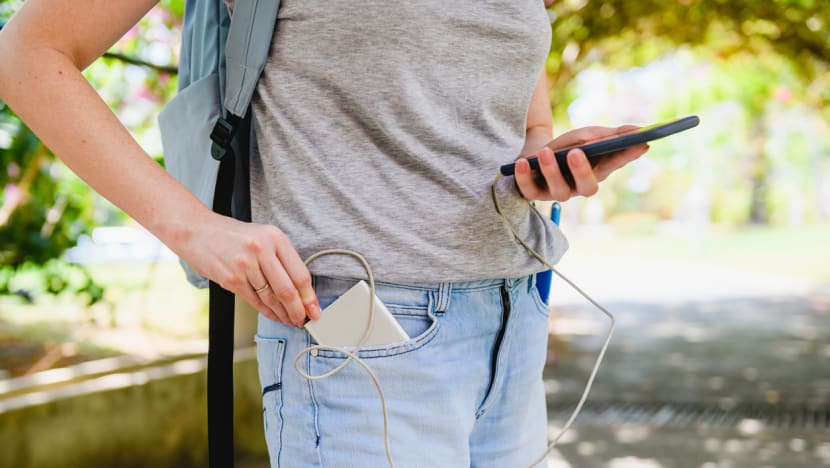Commentary: What we miss on vacation when we’re constantly charging our devices
Portable chargers have become an essential item on travel packing lists, but it’s more important to recharge our minds and body while on holiday, says writer Desiree Koh.

Being unable to use a power bank on flights can cause anxiety for some travellers, and not all airlines provide in-seat charging ports. (Photo: iStock/O_Lypa)

This audio is generated by an AI tool.
SINGAPORE: Airlines such as Singapore Airlines and Scoot have banned the use of power banks during flights, after several incidents of the portable chargers overheating and catching fire in aircraft cabins.
Most travellers would agree that flight safety is a top priority. But for some, being unable to use a power bank can cause anxiety, and not all airlines provide in-seat charging ports. Travellers may fret over running out of juice on a long-haul flight, or worse, arriving at their destination with a flat battery.
I understand. My iPhone doubles as my only camera, so I always carry a power bank during my travels.
When I embarked on a Mount Kilimanjaro expedition, my biggest fear wasn’t the physical extremity of scaling 5,895m. I was terrified of leaving the mountain without a complete set of pictures shot by me. I couldn’t bear the thought of this once-in-a-lifetime endeavour being captured from someone else’s perspective, even by the team’s photojournalist. I needed to tell my own story across multiple Facebook albums.
Those were pre-smartphone days, so I packed two cameras. I invested in extra batteries for each and obsessively confirmed they were fully charged – there would be no electricity for the entire seven-day trek. I even brought a battery-powered charger for those batteries in case of emergency.
Happy ending: I reached the peak of Kilimanjaro, and took all the pictures I wanted.
DATA USAGE IS SAPPING OUR DEVICES
But snapping pictures doesn’t sap a device’s battery – data usage does. Smartphones in airplane mode last remarkably long. Michaela Mannion, 44, spent four days caving in Vietnam last June, taking hundreds of images and videos. She recharged her iPhone just once to about 50 per cent, and emerged with plenty of battery to spare.
“I captured not only the beauty of nature to my heart’s content, but also enjoyed it without constant messages and notifications,” she said.
The truth is, we’re running our smartphone batteries to the ground because we’re chronically online. Beyond the necessities of navigation apps and on-the-go information checks, leisure travellers are often plugged to social media and messaging platforms. Worse, they may be peeking at work emails.
I used to scoff at tourists wandering around while livestreaming themselves, unaware that their outstretched arms and running commentary are a public nuisance. I couldn’t understand why anyone would invest time, effort and money on travelling, yet drift through UNESCO landmarks and trendy restaurants with their spirit lodged in a virtual dimension.
MOMENTS WORTH SHARING ONLINE
But now, my attitude is kinder, even at tourist hotspots like the Trevi Fountain. After COVID-19 brought travel to a halt, I count my blessings – every getaway is a privilege that people should enjoy however they like.
If being in constant contact with friends and receiving a flow of social media updates makes sightseeing enjoyable, then we can’t deny that these elements are part of any itinerary in this new era of travel.
There are also travellers for whom big vacations and hard-to-reach places are a rare treat. They simply can’t wait to share everything via video calls, beaming the excitement to folks back home.
I’ll never forget being on the Austrian Alps with my mom, who wouldn’t leave until we got the perfect cut of her twirling like Julie Andrews in the opening scene of The Sound Of Music – one of our favourite movies.
After 10 minutes of filming, my face and mood dropped drastically. But my then-62-year-old mum reminded, “When will I ever come back here and have such fun? It’ll always be a joy to relive this video, especially since I did it with you.”
Over post-hike beers, my mum set the clip to the movie’s title song, and uploaded it to Facebook. She delighted in interacting with people who left comments in the following days.
TRAVEL SHOULD RECHARGE YOUR MIND AND SOUL
When I travel, I prefer to be fully present, engaging in real experiences and making new friends. But on longer spells abroad, I compromise by checking in on work throughout the day. Taking a 15-minute WhatsApp call on a mountain trail overlooking the Amalfi Coast isn’t cause for complaint.

For those who need a more hands-on approach to shutting off, there is a proliferation of digital detox tours and resorts that lock up your digital devices in safe boxes. JOMO – the Joy Of Missing Out – is a major travel trend for 2025.
Data connectivity means breaking news, work calls and home emergencies can barge in on vacations. We must know how to compartmentalise these interruptions to get the most out of our travels.
The most important power bank is a positively charged one of mind and soul. If it’s near empty when you arrive for your holiday, that’s your cue to recharge.
Desiree Koh is a freelance writer based in Singapore.
















